Teaching Multi-Criteria Decision Making Based on Sustainability Factors Applied to Road Projects
Abstract
:1. Introduction
2. Background
2.1. Multi-Criteria Decision Making
2.1.1. Weighting Rating and Calculating (WRC)
- Factors: An element, part, or component of a decision. When assessing sustainability, factors should represent economic, social, and environmental aspects.
- Criterion: A decision rule or a guideline. A “must” criterion represents conditions each alternative must satisfy. A ”want” criterion represents the preferences of one or multiple decision-makers. This guide is similar to the one proposed by the Kepner-Tregoe decision analysis technique [27].
- In its methodology, the first step is to identify the selection alternatives from which to choose. Second, you must identify the factors and evaluation criteria for these alternatives, which are key for the decision-maker in the process of making his or her decision. Third, the factors should be given weights (wi) directly; these indicate the importance of each factor to the decision-maker and should be expressed as a percentage. As a restriction, the sum of the weights should be 100%. Fourth, the alternatives should be rated for each factor (ui); this rating will depend on the characteristics of each alternative, and a verbal scale with an associated score can be used to facilitate the choice of rating. In the last step, the value of each alternative is calculated as follows: (∑ wi x ui), where wi is the weight of the factors, and ui is the factor score for each alternative [10,24]. Figure 1 shows the structure of the WRC method.
2.1.2. Choosing by Advantage (CBA)
- Alternative corresponds to two or more people, items, or plans from which one will be chosen. It can also be understood as the possible options or actions available and from which one wants to choose.
- Factors are elements, parts, or components of a decision, those that contain data necessary to make a decision, and that affect the preference of the alternatives.
- Attributes are the characteristics, quantity, or quality of an alternative
- Criteria correspond to standards, rules, tests (trials), or any standard on which a desired or required decision or judgment can be based
- The advantage is the benefit, gain, or improvement, the difference between the attributes of two alternatives.
2.1.3. Analytic Hierarchy Process (AHP)
2.2. Sustainability Factors
3. Research Process
3.1. Contextualization
3.2. Design and Planning of Simulation Activity
- Project 1—Basic Road for Conservation (CBC) Route T—308, Valdivia, Chile: Conservation project through the application of a primer and asphalt seal type Cape Seal (simple asphalt surface treatment plus asphalt grout) of the 6.47 km route with 6 m wide roadway. The route benefits the inhabitants of Chancoyán, a rural sector of the commune of Valdivia, whose population is approximately 60 people.
- Project 2—Basic Road for Conservation, Route F—348, Valparaiso, Chile: It contemplates the execution of simple surface treatment, sanitation, and road safety works on the 3.32km long route with a 5 m wide roadway. The route benefits mainly the population adjacent to the route, who live mainly in plots and farms with areas of crops that can be affected, as well as the health of people, by the current condition of the route, which shows high concentrations of suspended material by vehicle traffic.
- Project 3—Basic Road to Curipaillaco, SR Route, Tirúa, Chile: The project considers a double surface treatment with polymer on a bidirectional roadway, cleaning of the strip, cutting excavation, earth moving, road safety works, road demarcation, and sanitation works. The route to be treated has a length of 5.17 km and presents several sections with strong slope and closed curves; the folder of rolling is of granular material, is in regular conditions, and has an average width of 5.5 m. The route benefits mainly the population adjacent to the route, who live mainly in large plots and farms with areas of cultivation and, besides, there are areas of native vegetation with high ecological value.
3.3. Application of Learning Activities
3.3.1. Example Use WRC Method
3.3.2. Example Using CBA Method
3.3.3. Example Using AHP Method
3.4. Assessment of Indicators
3.4.1. Personal Satisfaction
3.4.2. Personal Frustration
3.4.3. Perceived Difficulty
3.4.4. Weight of Sustainability Dimensions
3.5. Statistical Metrics Analysis
4. Results and Discussion
4.1. Indicator Results
4.1.1. Personal Satisfaction
4.1.2. Personal Frustration
4.1.3. Perceived Difficulty
4.2. Sustainability Dimensions
5. Conclusions
Author Contributions
Funding
Acknowledgments
Conflicts of Interest
References
- Rosetti, M.P. La Sostenibilidad en la Infraestructura. In Proceedings of the Conferencia LEAN en el Sector Público (LIPS), Santiago de Chile, Chile, 5–7 December 2017. [Google Scholar]
- Acevedo Agudelo, H.; Vásquez Hernández, A.; Ramirez Cardona, D.A. Gestión y Ambiente Actuality and necessity in the construction sector in colombia. Rev. Gest. Ambient. 2012, 15, 105–118. [Google Scholar]
- Rodríguez, F.; Fernández, G. Sustainable engineering: New objectives for construction projects. Rev. Ing. Constr. 2010, 25, 147–160. [Google Scholar] [CrossRef] [Green Version]
- United Nations. Transforming our World: The 2030 Agenda for Sustainable Development. Available online: https://sustainabledevelopment.un.org/post2015/transformingourworld (accessed on 17 August 2020).
- Krídlová, E.; Selecká, I.; Vilceková, S.; Burák, D.; Sedláková, A. Evaluation of Family Houses in Slovakia Using a Building Environmental Assessment System. Sustainability 2020, 12, 6524. [Google Scholar] [CrossRef]
- Bragança, L.; Mateus, R.; Koukkari, H. Building Sustainability Assessment. Sustainability 2010, 2, 2010–2023. [Google Scholar] [CrossRef] [Green Version]
- Zavadskas, E.K.; Šaparauskas, J.; Antuchevičienė, J. Sustainability in Construction Engineering. Sustainability 2018, 10, 2236. [Google Scholar] [CrossRef] [Green Version]
- Stojčić, M.; Zavadskas, E.K.; Pamučar, D.; Stević, Ž.; Mardani, A. Application of MCDM methods in sustainability engineering: A literature review 2008–2018. Symmetry 2019, 11, 350. [Google Scholar] [CrossRef] [Green Version]
- Sierra, L.A.; Yepes, V.; Pellicer, E. A review of multi-criteria assessment of the social sustainability of infrastructures. J. Clean. Prod. 2018, 187, 496–513. [Google Scholar] [CrossRef]
- Arroyo, P. Exploring Decision-Making Methods for Sustainable Design in Comercial Buildings. Ph.D. Thesis, University of California, Berkeley, CA, USA, 2014. [Google Scholar]
- Harris, R. Introduction to Decision Making. Available online: https://www.virtualsalt.com/crebook5.htm (accessed on 24 September 2019).
- Mosadeghi, R.; Warnken, J.; Tomlinson, R.; Mirfenderesk, H. Uncertainty analysis in the application of multi-criteria decision making methods in Australian strategic environmental decisions. J. Environ. Plan. Manag. 2013, 56, 1097–1124. [Google Scholar] [CrossRef] [Green Version]
- Mayor, J.; Botero, S.; González-Ruiz, J.D. Modelo de decisión multicriterio difuso para la selección de contratistas en proyectos de infraestructura: Caso Colombia. Obras Proy. 2016, 20, 56–74. [Google Scholar] [CrossRef]
- Subdirección de Mantenimiento/Subdepartamento de Caminos Básicos. In Texto Guia Caminos Basicos por Conservacion; Ministerio de Obras Públicas de Chile: Santiago de Chile, Chile, 2012.
- Zavadskas, E.K.; Antuchevičienė, J.; Kapliński, O. Multi-criteria decision making in civil engineering: Part I—A state-of-the-art survey. Eng. Struct. Technol. 2015, 7, 103–113. [Google Scholar] [CrossRef]
- Zavadskas, E.K.; Antuchevičienė, J.; Kapliński, O. Multi-criteria decision making in civil engineering. Part II—Applications. Eng. Struct. Technol. 2016, 7, 151–167. [Google Scholar] [CrossRef]
- Zavadskas, E.K.; Antucheviciene, J.; Vilutiene, T.; Adeli, H. Sustainable decision-making in civil engineering, construction and building technology. Sustainability 2017, 10, 14. [Google Scholar] [CrossRef] [Green Version]
- Aguayo, O. Estimación del Impacto de un Programa Masivo de Pavimentación de Caminos Rurales Sobre las Emisiones de CO2 en Chile; Pontificia Universidad Católica de Valparaíso: Santiago de Chile, Chile, 2017. [Google Scholar]
- Pellicer, E.; Sierra, L.A.; Yepes, V. Appraisal of Infrastructure Sustainability by Graduate Students using an Active-learning Method. J. Clean. Prod. 2016, 113, 884–896. [Google Scholar] [CrossRef] [Green Version]
- Navarro Martínez, I.; Martí Albiñana, J.V.; Yepes Piqueras, V. Multi-Criteria Decision Making Techniques in Civil Engineering Education for Sustainability. In Proceedings of the ICERI2018, Seville, Spain, 12–14 November 2018; Volume 1, pp. 9798–9807. [Google Scholar]
- Ogrodnik, K. Multi-Criteria Analysis of Design Solutions in Architecture and Engineering: Review of Applications and a Case Study. Buildings 2019, 9, 244. [Google Scholar] [CrossRef] [Green Version]
- Arroyo, P.; Tommelein, I.; Ballard, G. Comparing multi-criteria decision-making methods to select sustainable alternatives in the AEC industry. J. Constr. Eng. Manag. 2014, 869–876. [Google Scholar] [CrossRef]
- Arroyo, P.; Fuenzalida, C.; Albert, A.; Hallowell, M.R. Collaborating in decision making of sustainable building design: An experimental study comparing CBA and WRC methods. Energy Build. 2016, 128, 132–142. [Google Scholar] [CrossRef]
- Crisóstomo, A.; Herrera, R.F. Metodología de toma de decisiones para la selección de subcontratos en la industria de la construcción. Obras Proy. 2018, 24, 28–40. [Google Scholar] [CrossRef] [Green Version]
- Schöttle, A.; Arroyo, P. Comparison of Weighting-Rating-Calculating, Best Value, and Choosing by Advantages for Bidder Selection. J. Constr. Eng. Manag. 2017, 143. [Google Scholar] [CrossRef]
- Suhr, J. The Choosing by Advantages Decisionmaking System; Greenwood Publishing Group: Westport, CT, USA, 1999. [Google Scholar]
- Baker, D.; Bridges, D.; Hunter, R.; Johnson, G.; Krupa, J.; Murphy, J.; Sorenson, K. Guidebook to Decision-Making Methods; Westinghouse Savannah River Company: Aiken, SC, USA, 2001; Volume 45. [Google Scholar]
- Arroyo, P.; Tommelein, I.D.; Ballard, G. Comparing weighting rating and calculating vs choosing by advantages to make design choices. In Proceedings of the 22nd Annual Conference of the International Group for Lean Construction: Understanding and Improving Project Based Production, Oslo, Norway, 25–27 June 2014; pp. 401–412. [Google Scholar]
- Grant, E.J.; Jones, J.R. A Decision-Making Framework for Vegetated Roofing System Selection. J. Green Build. 2008, 3, 138–153. [Google Scholar] [CrossRef] [Green Version]
- Arroyo, P.; Tommelein, I.D.; Ballard, G. Selecting Globally Sustainable Materials: A Case Study Using Choosing by Advantages. J. Constr. Eng. Manag. 2016, 142, 1–10. [Google Scholar] [CrossRef]
- Arroyo, P.; Tommelein, I.D.; Ballard, G. Deciding a sustainable alternative by “choosing by advantages” in the AEC industry. In Proceedings of the 20th Annual Conference of the International Group for Lean Construction (IGLC), San Diego, CA, USA, 17–22 July 2012. [Google Scholar]
- Arroyo, P.; Tommelein, I.D.; Ballard, G.; Rumsey, P. Choosing by advantages: A case study for selecting an HVAC system for a net zero energy museum. Energy Build. 2016, 111, 26–36. [Google Scholar] [CrossRef]
- Arroyo, P.; Tommelein, I.D.; Ballard, G. Using ‘Choosing By Advantages’ To Select Ceiling Tile From A Global Sustainable perspective. In Proceedings of the IGLC-21, Fortaleza, Brazil; 2013; Volume 1, pp. 309–318. [Google Scholar]
- Arroyo, P.; Molinos-Senante, M. Selecting appropriate wastewater treatment technologies using a choosing-by-advantages approach. Sci. Total Environ. 2018, 625, 819–827. [Google Scholar] [CrossRef] [PubMed]
- López, J.E.; Dolado, J.J. Estudio de los Métodos de Estimación: AHP y Redes Bayesianas; Departamento de Lenguajes y Sistemas, Universidad del País Vasco: Vitoria-Gasteiz, Spain, 2007. [Google Scholar]
- Sierra, L. El Proceso Analítico Jerárquico para la valoración de la sostenibilidad de las infraestructuras. Rev. Cient. Tecnol. Dep. Ing. Obras Civiles RIOC 2016, 6, 27–36. [Google Scholar]
- Zanazzi, J.L. Anomalías y Supervivencia en el Método de Toma de Decisiones de Saaty. In Problemas del Conocimiento en Ingeniería y Geología; Godoy, L.A., Ed.; Universidad de Cordoba: Córdoba, Argentina, 2003; Volume I, pp. 148–170. [Google Scholar]
- Brundtland, G.H. Our Common Future; WCED: New York, NY, USA, 1987. [Google Scholar]
- United Nations. Agenda 21: Action Plan for the Next Country. In Proceedings of the Conference on Environment and Development, Río de Janeiro, Brazil, 3–14 June 1992. [Google Scholar]
- Cervantes Torre-marín, G.; Sosa Granados, R.; Rodríguez-Herrera, G.; Robles-Martínez, F. Ecología industrial y desarrollo sustentable. Ing. Rev. Acad. 2009, 13, 63–70. [Google Scholar]
- Todorov, V.; Marinova, D. Modelling sustainability. Math. Comput. Simul. 2011, 81, 1397–1408. [Google Scholar] [CrossRef] [Green Version]
- Waas, T.; Hugé, J.; Verbruggen, A.; Wright, T. Sustainable Development: A Bird’s Eye View. Sustainability 2011, 3, 1637–1661. [Google Scholar] [CrossRef] [Green Version]
- Alarcón Núñez, D.B. Modelo Integrado de Valor para Estructuras Sostenibles; Universitat Politècnica de Catalunya: Barcelona, Spain, 2005. [Google Scholar]
- International Energy Agency (IEA); Global Alliance for Buildings and Construction; United Nations Environment Programme (UNEP). 2019 Global Status Report for Buildings and Construction: Towards a Zero-Emissions, Efficient and Resilient Buildings and Construction Sector; IEA: Paris, France, 2019. [Google Scholar]
- Sev, A. How Can the Construction Industry Contribute to Sustainable Development? Sustain. Dev. 2009, 17, 161–173. [Google Scholar] [CrossRef]
- Svenningsen, N. The Sustainable Buildings and Construction Initiative. In Proceedings of the UNEP FI Property Investment Group; United Nations Environment Programme: Nairobi, Kenya, 2007; pp. 1–22. [Google Scholar]
- Choi, J. CoBi: Bio-Sensing Building Mechanical System Controls for Sustainably Enhancing Individual Thermal Comfort; Carnegie Mellon University: Pittsburgh, PA, USA, 2010. [Google Scholar]
- United Nations Environment Programme (UNEP). Global Environment Outlook 3: Past, Present and Future Perspectives, 1st ed.; Clarke, R., Lamb, R., Ward, D.R., Eds.; Easthscan Publications: London, UK, 2002. [Google Scholar]
- Echaveguren, T. Metodología de Evaluación de Caminos de Bajo Estandar para la XI Región; Universidad de Concepción: Bío-Bío Region, Chile, 1994. [Google Scholar]
- Chamorro Giné, M.A. Development of a Sustainable Management System for Rural Road Networks in Developing Countries; University of Waterloo: Waterloo, ON, Canada, 2012. [Google Scholar]
- Ordoñez Díaz, M.M.; Meneses Silva, L.C. Criterios e Indicadores de Sostenibilidad en el Subsector Vial. Cienc. Ing. Neogranad. 2015, 25, 81–98. [Google Scholar] [CrossRef] [Green Version]
- De Solminihac, H.; Echaveguren, T.; Chamorro, A. Gestion de Infraestructura Vial; Ediciones, U.C., Ed.; Ediciones UC: Santiago de Chile, Chile, 2018; ISBN 978-956-14-2275-9. [Google Scholar]
- Paredes-Vega, G.; Herrera, R.F.; Gómez, M.A. Indicadores de Sustentabilidad para la Toma de Decisiones en Proyectos de Caminos Básicos. Novasinerg. Rev. Digit. Cienc. Ing. Tecnol. 2019, 2, 38–48. [Google Scholar] [CrossRef]
- Urrejola Marín, A. Edición Especial: Control de Polvo en Faenas. Soluciones que mejoran la calidad de vida y cuidan la salud laboral. El Mercur. 2018, pp. 10–11. Available online: http://www.edicionesespeciales.elmercurio.com/destacadas/detalle/index.asp?idnoticia=201506251942526 (accessed on 30 October 2020).




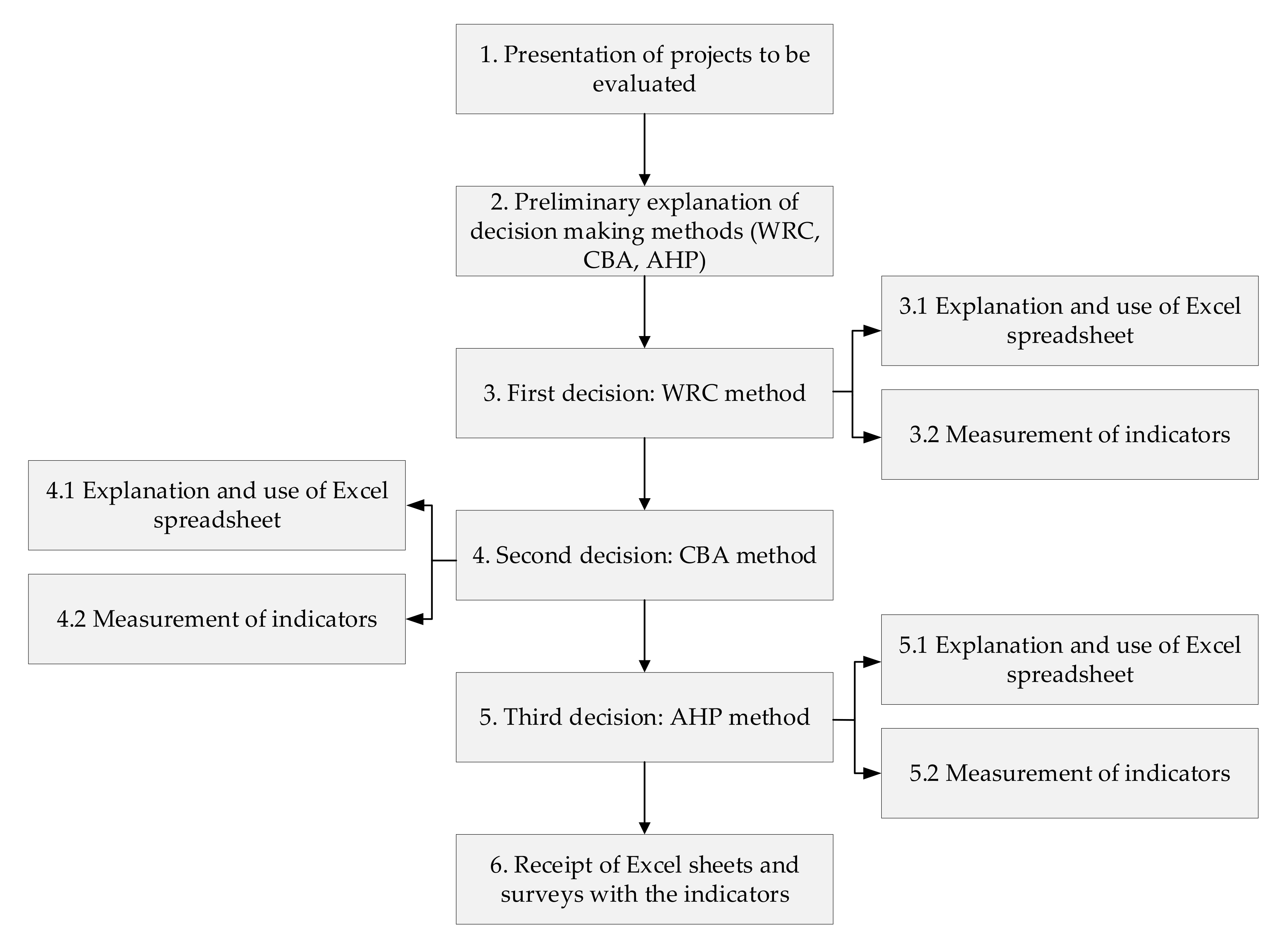

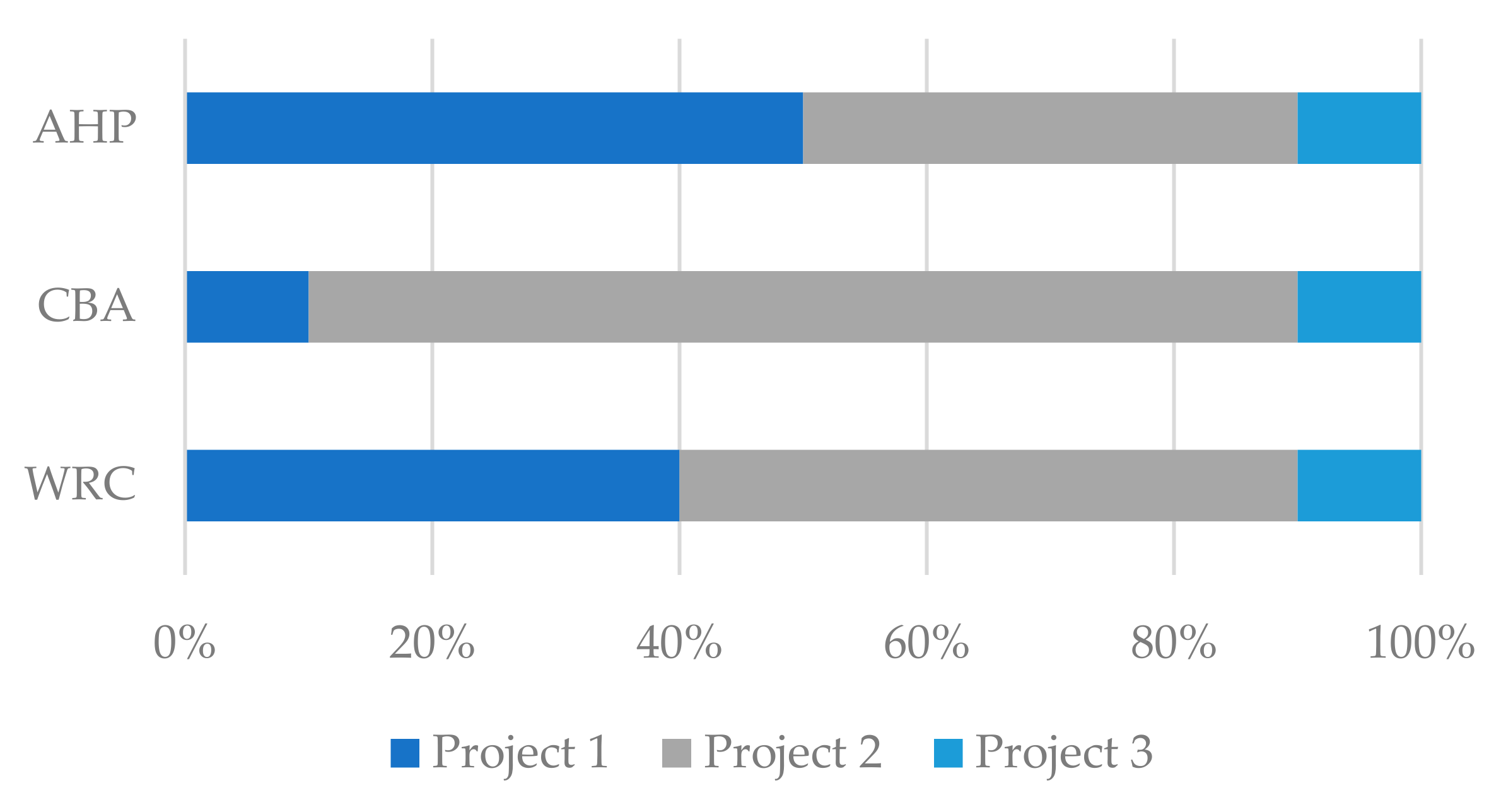
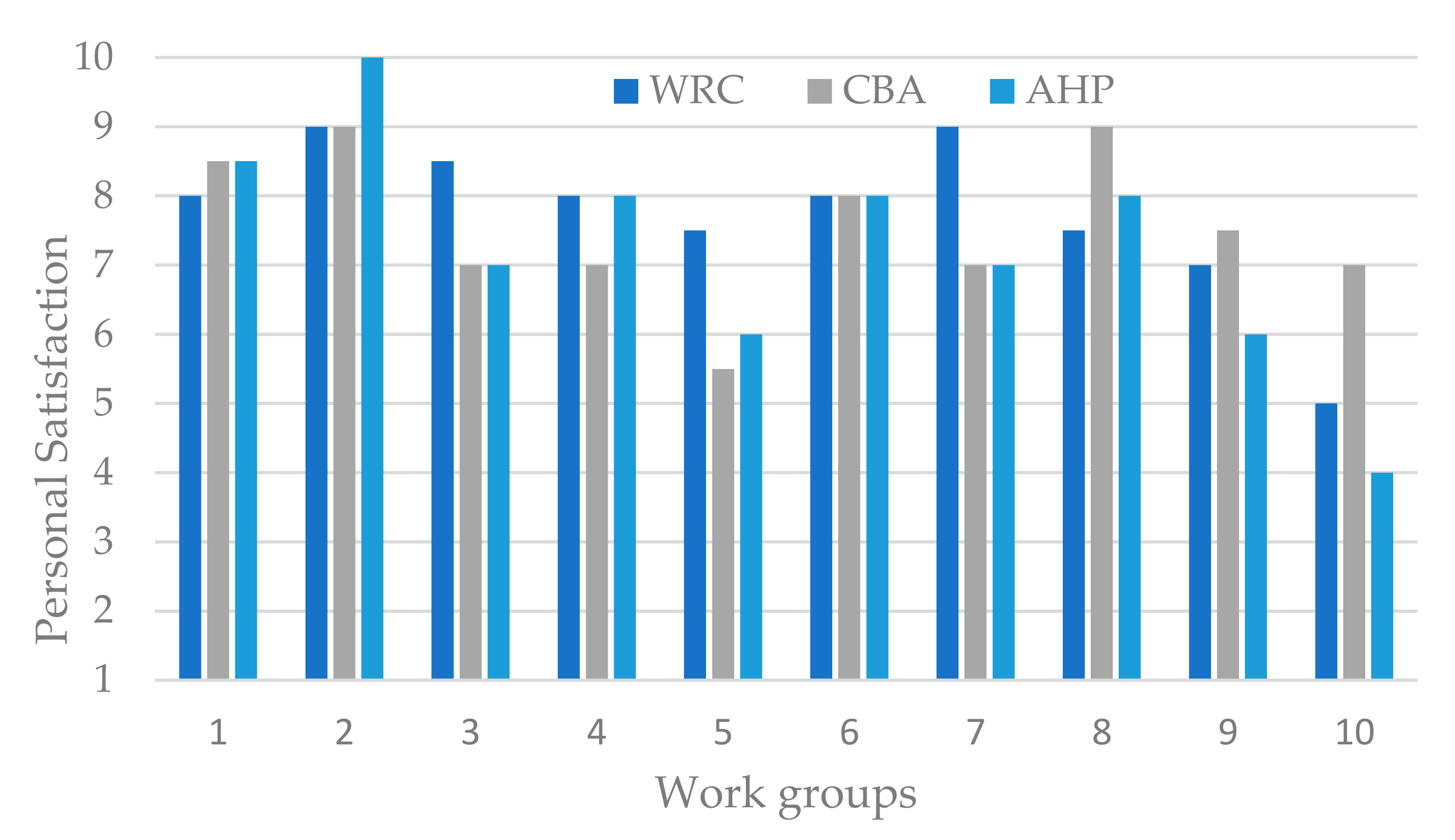

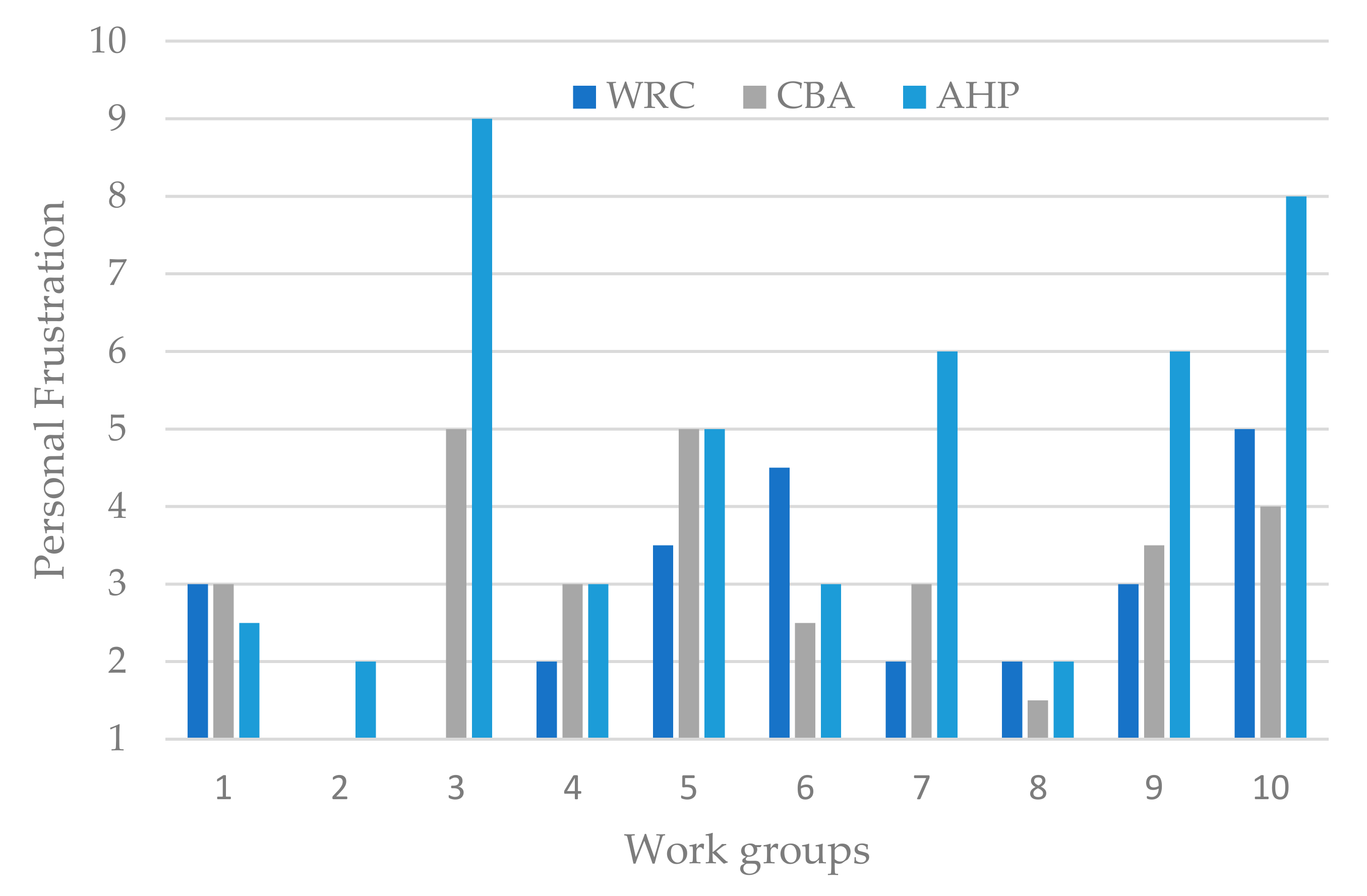
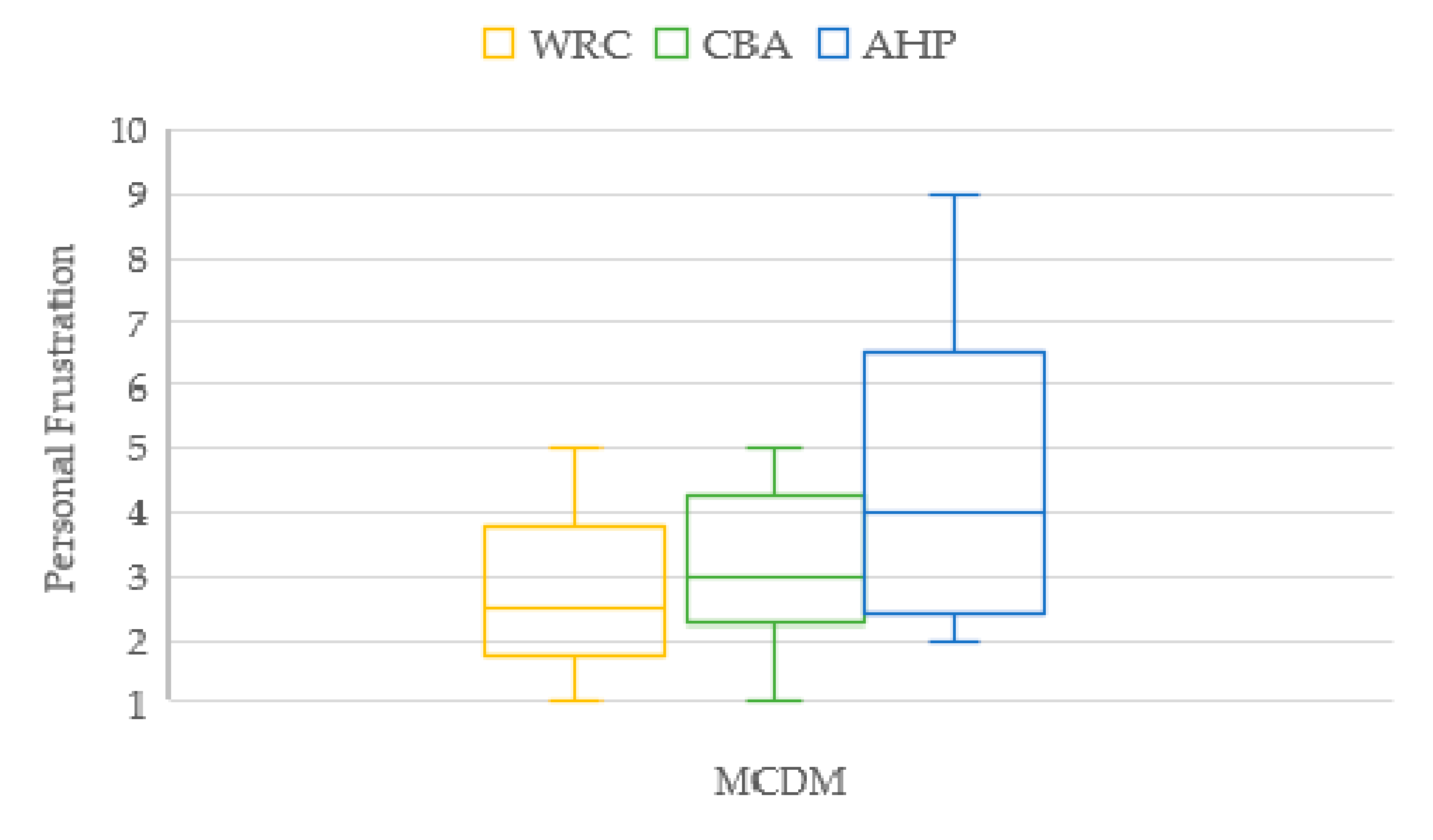
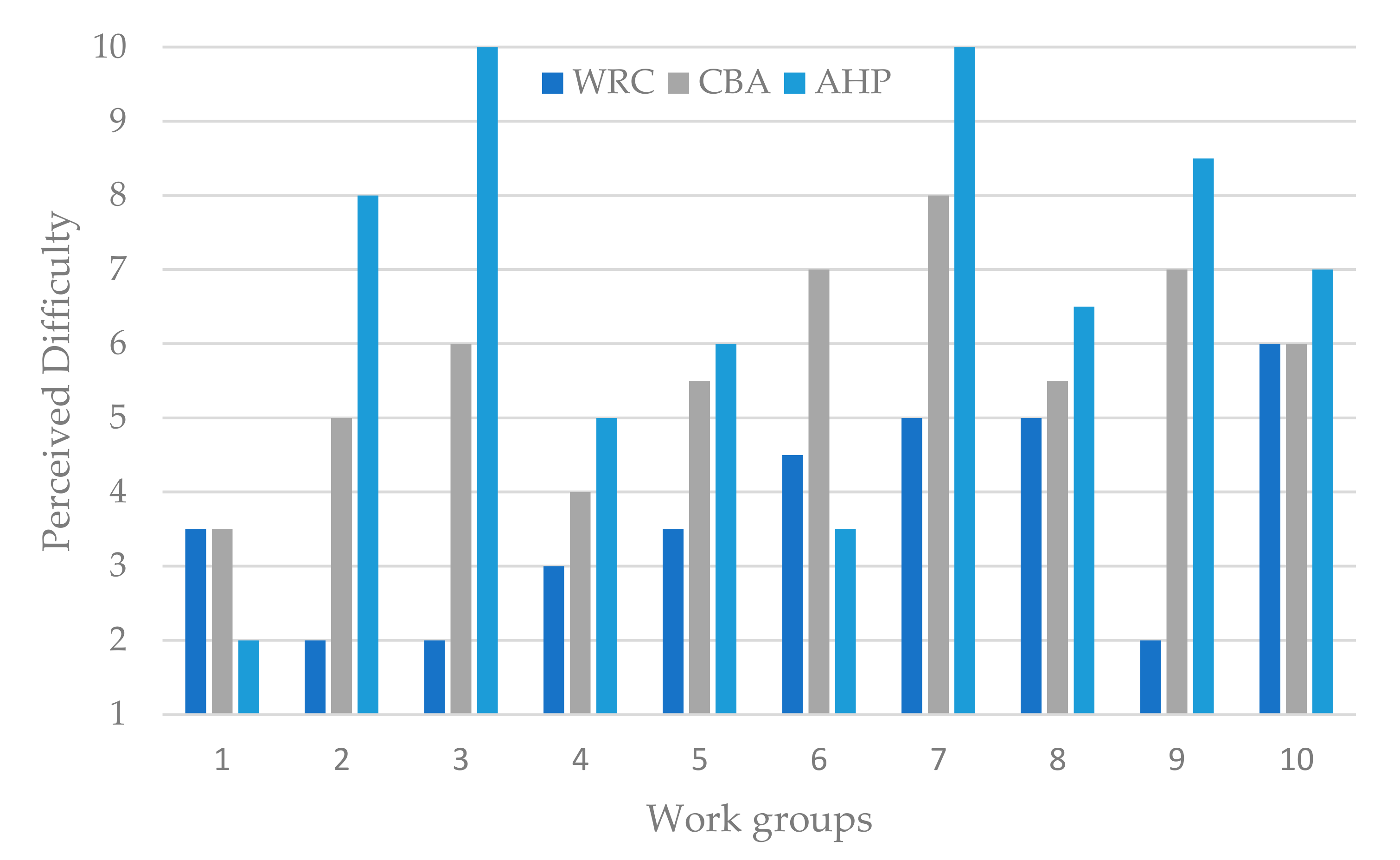
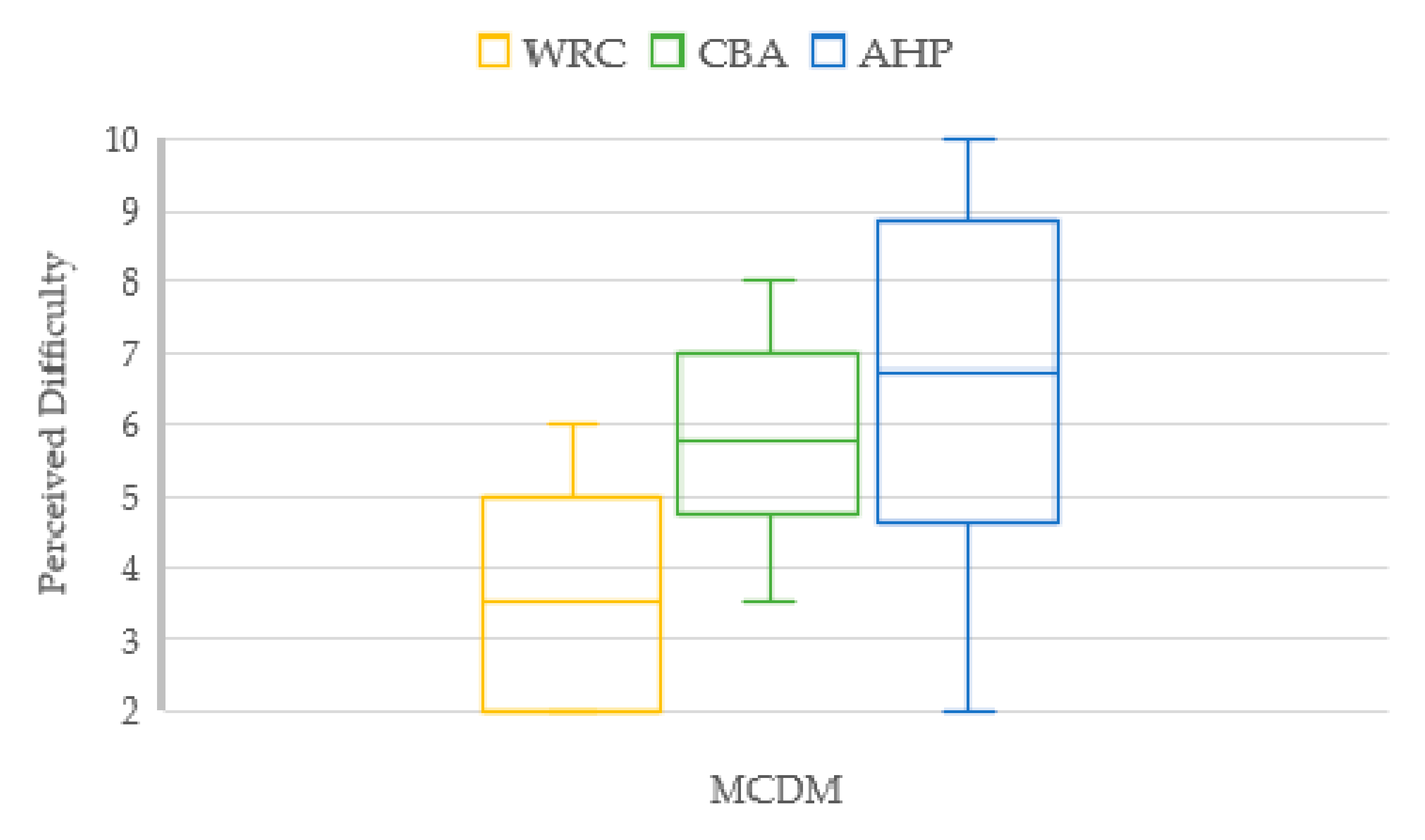

| Value | Short Definition | Definition |
|---|---|---|
| 1 | Equal importance | Criterion A is equally important as criterion B |
| 3 | Moderate importance | Experience and judgment slightly favor criterion A over criterion B |
| 5 | Strong importance | Experience and judgment strongly favor criterion A over criterion B |
| 7 | Very strong importance | Criterion A is much more important than criterion B |
| 9 | Extreme importance | The greatest importance of criterion A over criterion B is beyond doubt |
| Factors | Description | Aspects to Be Evaluated and Indicators |
|---|---|---|
| Ecosystem area affected by the project | Quantify the total area of ecosystems with high ecological value affected by the project. | Number of hectares of protected ecosystems and habitats or of high ecological value. |
| Endangered species living in the area | Identify natural habitats with endangered species along the road. | Intervention surface of native forest and/or protected species habitat. |
| Use of materials from the area | Selection and use of local materials to minimize the impact on the environment of transporting materials. Moreover, contribute to income sources for the local economy. | Percentage of materials coming from the area. |
| Factors | Description | Aspects to Be Evaluated and Indicators |
|---|---|---|
| Improve the quality of life of the community | The project provides significant benefits to the affected communities that reduce or eliminate negative impacts. That is, it has a net positive impact, considering aspects such as health and safety of people. | -Number of people living near the road who have health problems. -Number of ppm of dust in suspension along the road. |
| Beneficiary population/population adjacent to the road | Quantify the number of people who benefit from conserving the road and those who live near the road. To determine the impacts generated in the community. | -Number of residents who benefit from the road (connectivity). -Concentration of neighboring population that benefits (dispersed, medium, concentrated). -Number of residents who live adjacent to the road (less than 100 m from the road). |
| Community organization level | Weighing the political influence that the community applies. | Level of organization and degree of the political activity of the benefited community (high, medium, or low). |
| Improve accessibility, road safety, and signaling on construction sites | Maintenance of acceptable levels of safety for road users, be they drivers, passengers, cyclists and/or pedestrians. | -Number of events per year in which the road is flooded or muddy. -Number of accidents per year registered on the road. |
| Improve community access and mobility | The location of the project improves community access and mobility between inland locations and/or brings people closer to the city and, therefore to health, education and commercial services. | - The road allows access to other interior villages -The road allows connection to urban centers and basic public services. |
| Promote the use of public transport | Improve the accessibility of public transport, contributing to the mobility of the community. | In case the improvement of the road allows access to public transport. |
| Presence of health service and/or historical place or cultural interest | Presence of places with high value for the community. | Presence of religious temple, headquarters, clinic, historical places and/or cultural interest in the road or adjacent sector to the route. |
| Presence of historical, cultural and/or archaeological heritage | Preserve historical and cultural sites important to the community. | The number of places of interest per kilometer of the route. |
| Factors | Description | Aspects to Be Evaluated and Indicators |
|---|---|---|
| Daily vehicle flow | Number of vehicles on the route. | Level of daily vehicular flow along the route (low, regular, medium, or high) |
| Periodicity of maintenance and replenishment of the route | Decrease the maintenance and material replacement work involved in preserving the route. | - Time interval between route maintenance. -Time interval between replacement of material in the route. |
| Typical road use before upgrading/associated travel time | It seeks to determine the use that users give to the route, such as trips to the city to access public services, agricultural transport, among others. | The number of users using the route according to the type of user (pedestrian, public transport passenger, cyclist, driver). |
| External monetary contributions | Consider the possible economic contribution of outsiders for the realization of the conservation project. | Monetary percentage of the investment as an external contribution to the project. |
| Local economic assessment/impact on local productivity | Quantify the economic impact of road paving in terms of increased connectivity to natural resource areas. | Travel time with the project (improved road) by the number of trucks on the road. |
| Predominant economic activities in the area | To value the possible economic impacts that the paving of the road has on the local economy. | Define the main activity of the area (agriculture, livestock, forestry, tourism, mining, urban, among others) |
| Affected farming area | Decrease the impacts that the suspended particles have on the surrounding farms. | Number of hectares of farms surrounding the route (less than 300 m) |
| Increased connectivity between communities | Determine the number of connected communities | The number of communities connected. |
| Ratio of local material use | Decrease the transport of materials to optimize the resources allocated to the project. | Distance to material production facilities. |
| Type of carpet | To value the impact according to the type of carpet that exists before the conservation. | Type of carpet before upgrading soil or gravel. |
| Road geometry | Identify the type of geometry that exists on the route to identify the level of difficulty of unpaved road traffic. | Classification of the route (flat, wavy, mountainous, with slopes, among others). |
| Average road width | Determine the width of the route to be paved to know if it complies with safety ranges. | The width of the roadway to be paved is less or more than 5 m. |
| Degree of consolidation of sanitation | Identify the degree of sanitation that the route has so that those that already have sanitation are more economical projects. | The presence of sanitation works on the route, the degree can be zero, medium, or high. |
| Network connected to the road network | The route to be conserved is linked to the road network of the state/country. | Membership of the route to the communal network enrolled in the road network (Yes/No answer). |
| Factors | Weight Factor | Project 1 | Score 1 | Project 2 | Score 2 | Project 3 | Score 3 |
|---|---|---|---|---|---|---|---|
| Qualification | Qualification | Qualification | |||||
| Ecosystem area affected by the project | 0.3 | Very good | 10 | Good | 8 | Good | 8 |
| Endangered species living in the area | 0.4 | Regular | 6 | Very good | 10 | Good | 8 |
| Use of materials from the area | 0.3 | Deficient | 4 | Regular | 6 | Regular | 6 |
| Total Score | 100% | - | 6.6 | - | 8.2 | - | 7.4 |
| Qualification | Very Deficient | Deficient | Regular | Good | Very Good | |||||
|---|---|---|---|---|---|---|---|---|---|---|
| Score | 1 | 2 | 3 | 4 | 5 | 6 | 7 | 8 | 9 | 10 |
| Factor | Criteria | Project 1 | Project 2 | Project 3 | ||||
|---|---|---|---|---|---|---|---|---|
| Ecosystem area affected by the project | The lower the number of hectares of protected ecosystems and habitats or of high ecological value, the better | Attribute | MB | B | B | |||
| Advantage | Id:1 | Project far from protected ecosystems | Id:2 | - | Id:3 | - | ||
| Imp | 80 | - | - | |||||
| Endangered species living in the area | The smaller the area of native forest and/or protected species habitat, the better | Attribute | R | MB | B | |||
| Advantage | Id:4 | - | Id:5 | There are no nearby areas | Id:6 | There are areas a few km | ||
| Imp | - | 80 | 60 | |||||
| Total Importance | 80 | 80 | 60 | |||||
| Total Project Cost | $636M | $259M | $772M | |||||
| Importance | 100 | 90 | 80 | 70 | 60 | 50 | 40 | 30 | 20 | 10 | 0 |
|---|---|---|---|---|---|---|---|---|---|---|---|
| Identification (Id) | 1–5 | 6 |
| Sub-Criteria A1: Ecosystem Area Affected by the Project | |||||||
| P1 | P2 | P3 | Standardized matrix | Average Vector | |||
| P1 | 1 | 7 | 5 | 0.74 | 0.78 | 0.71 | 0.75 |
| P2 | 1/7 | 1 | 1 | 0.11 | 0.11 | 0.14 | 0.12 |
| P3 | 1/5 | 1 | 1 | 0.15 | 0.11 | 0.14 | 0.13 |
| Total | 1.34 | 9 | 7 | ||||
| Sub-Criteria A2: Endangered Species Living in The Area | |||||||
| P1 | P2 | P3 | Standardized matrix | Average Vector | |||
| P1 | 1 | 1/7 | 1/5 | 0.08 | 0.1 | 0.05 | 0.07 |
| P2 | 7 | 1 | 3 | 0.54 | 0.68 | 0.71 | 0.64 |
| P3 | 5 | 1/3 | 1 | 0.38 | 0.23 | 0.24 | 0.28 |
| Total | 13 | 1.48 | 4.2 | ||||
| Criteria: Environmental Dimension | |||||||
| A1 | A2 | Standardized matrix | Average Vector | ||||
| A1 | 1 | 3 | 0.75 | 0.75 | 0.75 | ||
| A2 | 1/3 | 1 | 0.25 | 0.25 | 0.25 | ||
| Total | 1.33 | 4 | |||||
| Weighting Factor | 0.75 | 0.25 | |
|---|---|---|---|
| Alternatives | A1 | A2 | Total |
| Project 1 | 0.75 | 0.07 | 0.58 |
| Project 2 | 0.12 | 0.64 | 0.25 |
| Project 3 | 0.13 | 0.28 | 0.17 |
| Comparison between MCDM | Statistic Parameter | p-Value | Ho | Are There Any Significant Differences? |
|---|---|---|---|---|
| WRC vs. CBA | U = 41/Z = −0.68 | 0.51 | Not rejected | NO |
| WRC vs. AHP | U = 39/Z = −0.83 | 0.42 | Not rejected | NO |
| CBA vs. AHP | U = 45/Z = −0.38 | 0.73 | Not rejected | NO |
| WRC vs. CBA vs. AHP | H = 0.89 | 0.64 | Not rejected | NO |
| Comparison between MCDM | Statistic Parameter | p-Value | Ho | Are There Any Significant Differences? |
|---|---|---|---|---|
| WRC vs. CBA | U = 39.5/Z = −0.79 | 0.44 | Not rejected | NO |
| WRC vs. AHP | U = 26.5/Z = −1.78 | 0.078 | Not rejected | NO |
| CBA vs. AHP | U = 35.5/Z = −1.1 | 0.29 | Not rejected | NO |
| WRC vs. CBA vs. AHP | H = 3.45 | 0.18 | Not rejected | NO |
| Comparison between MCDM | Statistic Parameter | p-Value | Ho | Are There Any Significant Differences? |
|---|---|---|---|---|
| WRC vs. CBA | U = 14/Z = −2.72 | 0.0069 | Rejected | YES |
| WRC vs. AHP | U = 16/Z = −2.57 | 0.011 | Rejected | YES |
| CBA vs. AHP | U = 36.5/Z = −1.02 | 0.323 | Not rejected | NO |
| WRC vs. CBA vs. AHP | H = 10.18 | 0.0068 | Rejected | YES |
Publisher’s Note: MDPI stays neutral with regard to jurisdictional claims in published maps and institutional affiliations. |
© 2020 by the authors. Licensee MDPI, Basel, Switzerland. This article is an open access article distributed under the terms and conditions of the Creative Commons Attribution (CC BY) license (http://creativecommons.org/licenses/by/4.0/).
Share and Cite
Paredes, G.; Herrera, R.F. Teaching Multi-Criteria Decision Making Based on Sustainability Factors Applied to Road Projects. Sustainability 2020, 12, 8930. https://doi.org/10.3390/su12218930
Paredes G, Herrera RF. Teaching Multi-Criteria Decision Making Based on Sustainability Factors Applied to Road Projects. Sustainability. 2020; 12(21):8930. https://doi.org/10.3390/su12218930
Chicago/Turabian StyleParedes, Gabriela, and Rodrigo F. Herrera. 2020. "Teaching Multi-Criteria Decision Making Based on Sustainability Factors Applied to Road Projects" Sustainability 12, no. 21: 8930. https://doi.org/10.3390/su12218930
APA StyleParedes, G., & Herrera, R. F. (2020). Teaching Multi-Criteria Decision Making Based on Sustainability Factors Applied to Road Projects. Sustainability, 12(21), 8930. https://doi.org/10.3390/su12218930







